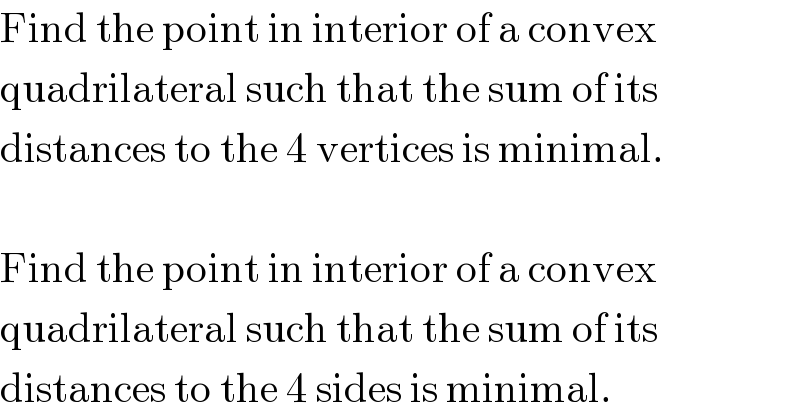
Question Number 17373 by mrW1 last updated on 04/Jul/17

$$\mathrm{Find}\:\mathrm{the}\:\mathrm{point}\:\mathrm{in}\:\mathrm{interior}\:\mathrm{of}\:\mathrm{a}\:\mathrm{convex} \\ $$$$\mathrm{quadrilateral}\:\mathrm{such}\:\mathrm{that}\:\mathrm{the}\:\mathrm{sum}\:\mathrm{of}\:\mathrm{its} \\ $$$$\mathrm{distances}\:\mathrm{to}\:\mathrm{the}\:\mathrm{4}\:\mathrm{vertices}\:\mathrm{is}\:\mathrm{minimal}. \\ $$$$ \\ $$$$\mathrm{Find}\:\mathrm{the}\:\mathrm{point}\:\mathrm{in}\:\mathrm{interior}\:\mathrm{of}\:\mathrm{a}\:\mathrm{convex} \\ $$$$\mathrm{quadrilateral}\:\mathrm{such}\:\mathrm{that}\:\mathrm{the}\:\mathrm{sum}\:\mathrm{of}\:\mathrm{its} \\ $$$$\mathrm{distances}\:\mathrm{to}\:\mathrm{the}\:\mathrm{4}\:\mathrm{sides}\:\mathrm{is}\:\mathrm{minimal}. \\ $$
Answered by ajfour last updated on 05/Jul/17

$$\mathrm{let}\:\mathrm{x}_{\mathrm{A}} \mathrm{be}\:\mathrm{the}\:\mathrm{distance}\:\mathrm{of}\:\mathrm{the}\:\mathrm{point}\:\left(\mathrm{P}\right) \\ $$$$\mathrm{from}\:\mathrm{vertex}\:\mathrm{A}\:\mathrm{and}\:\mathrm{so}\:\mathrm{on}\:.. \\ $$$$\:\mathrm{let}\:\mathrm{L}=\mathrm{x}_{\mathrm{A}} +\mathrm{x}_{\mathrm{C}} +\mathrm{x}_{\mathrm{B}} +\mathrm{x}_{\mathrm{D}} \\ $$$$\:\:\:\:\:\mathrm{x}_{\mathrm{A}} +\mathrm{x}_{\mathrm{C}} \:\geqslant\:\mathrm{AC} \\ $$$$\:\:\:\:\:\mathrm{x}_{\mathrm{B}} +\mathrm{x}_{\mathrm{D}} \:\geqslant\:\mathrm{BD} \\ $$$$\mathrm{so}\:\mathrm{L}_{\mathrm{minimum}} =\:\mathrm{AC}+\mathrm{BD} \\ $$$$\mathrm{so}\:\mathrm{point}\:\mathrm{P}\:\mathrm{is}\:\mathrm{the}\:\mathrm{intersection}\:\mathrm{of} \\ $$$$\mathrm{the}\:\mathrm{diagonals}\:\mathrm{of}\:\mathrm{the}\:\mathrm{quadrilateral}. \\ $$$$ \\ $$$$\mathrm{when}\:\mathrm{sum}\:\mathrm{of}\:\mathrm{the}\:\mathrm{distances}\:\mathrm{of}\:\mathrm{a}\:\mathrm{point} \\ $$$$\mathrm{from}\:\mathrm{the}\:\mathrm{four}\:\mathrm{sides}\:\mathrm{is}\:\mathrm{minimum} \\ $$$$\mathrm{the}\:\mathrm{point}\:\mathrm{is}\:\mathrm{probably}\:\mathrm{at}\:\mathrm{the} \\ $$$$\mathrm{corner}\:\mathrm{of}\:\mathrm{the}\:\mathrm{quadrilateral}\:\mathrm{having} \\ $$$$\mathrm{the}\:\mathrm{greatest}\:\mathrm{angle}\:\left(\mathrm{cannot}\:\mathrm{prove}\:\mathrm{yet}\right). \\ $$
Commented by mrW1 last updated on 05/Jul/17

$$\mathrm{answer}\:\mathrm{to}\:\mathrm{part}\:\mathrm{1}\:\mathrm{is}\:\mathrm{correct}. \\ $$$$\mathrm{answer}\:\mathrm{to}\:\mathrm{part}\:\mathrm{2}\:\mathrm{is}\:\mathrm{to}\:\mathrm{check}.\:\mathrm{please} \\ $$$$\mathrm{consider}\:\mathrm{different}\:\mathrm{cases}.\: \\ $$
Answered by mrW1 last updated on 05/Jul/17

$$\mathrm{To}\:\mathrm{part}\:\mathrm{1}: \\ $$$$\mathrm{The}\:\mathrm{answer}\:\mathrm{is}\:\mathrm{as}\:\mathrm{given}\:\mathrm{by}\:\mathrm{ajfour}\:\mathrm{the} \\ $$$$\mathrm{intersection}\:\mathrm{point}\:\mathrm{of}\:\mathrm{the}\:\mathrm{diagonals}. \\ $$$$ \\ $$$$\mathrm{To}\:\mathrm{part}\:\mathrm{2}: \\ $$$$\mathrm{case}\:\mathrm{1}: \\ $$$$\mathrm{both}\:\mathrm{pairs}\:\mathrm{of}\:\mathrm{opposite}\:\mathrm{sides}\:\mathrm{are}\:\mathrm{not} \\ $$$$\mathrm{parallel},\:\mathrm{see}\:\mathrm{diagram}. \\ $$$$\mathrm{Point}\:\mathrm{A}\:\mathrm{is}\:\mathrm{the}\:\mathrm{point}\:\mathrm{whose}\:\mathrm{sum}\:\mathrm{of} \\ $$$$\mathrm{distances}\:\mathrm{to}\:\mathrm{the}\:\mathrm{sides}\:\mathrm{is}\:\mathrm{minimal}. \\ $$
Commented by mrW1 last updated on 05/Jul/17

Commented by mrW1 last updated on 05/Jul/17

$$\mathrm{case}\:\mathrm{2}: \\ $$$$\mathrm{one}\:\mathrm{pair}\:\mathrm{of}\:\mathrm{opposite}\:\mathrm{sides}\:\mathrm{is}\:\mathrm{parallel}. \\ $$$$\mathrm{The}\:\mathrm{point}\:\mathrm{which}\:\mathrm{is}\:\mathrm{closest}\:\mathrm{to}\:\mathrm{K}\:\mathrm{is}\:\mathrm{the} \\ $$$$\mathrm{solution},\:\mathrm{here}\:\mathrm{it}\:\mathrm{is}\:\mathrm{point}\:\mathrm{A}. \\ $$
Commented by mrW1 last updated on 05/Jul/17

Commented by mrW1 last updated on 05/Jul/17

$$\mathrm{case}\:\mathrm{3}: \\ $$$$\mathrm{both}\:\mathrm{pairs}\:\mathrm{of}\:\mathrm{opposite}\:\mathrm{sides}\:\mathrm{are}\:\mathrm{parallel}. \\ $$$$\mathrm{The}\:\mathrm{sum}\:\mathrm{of}\:\mathrm{distances}\:\mathrm{from}\:\mathrm{every}\:\mathrm{point} \\ $$$$\mathrm{to}\:\mathrm{the}\:\mathrm{sides}\:\mathrm{is}\:\mathrm{constant}. \\ $$
Commented by mrW1 last updated on 05/Jul/17

